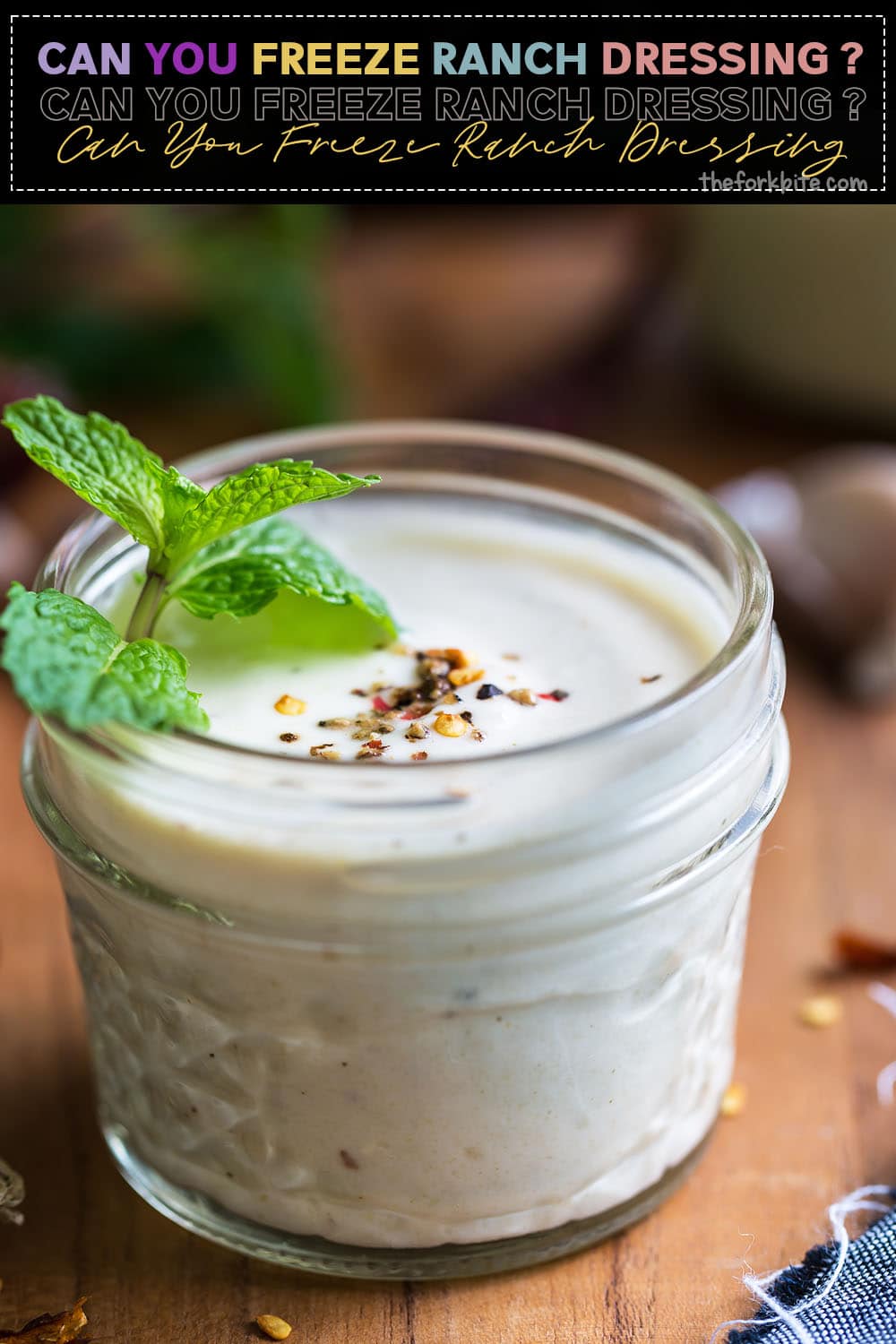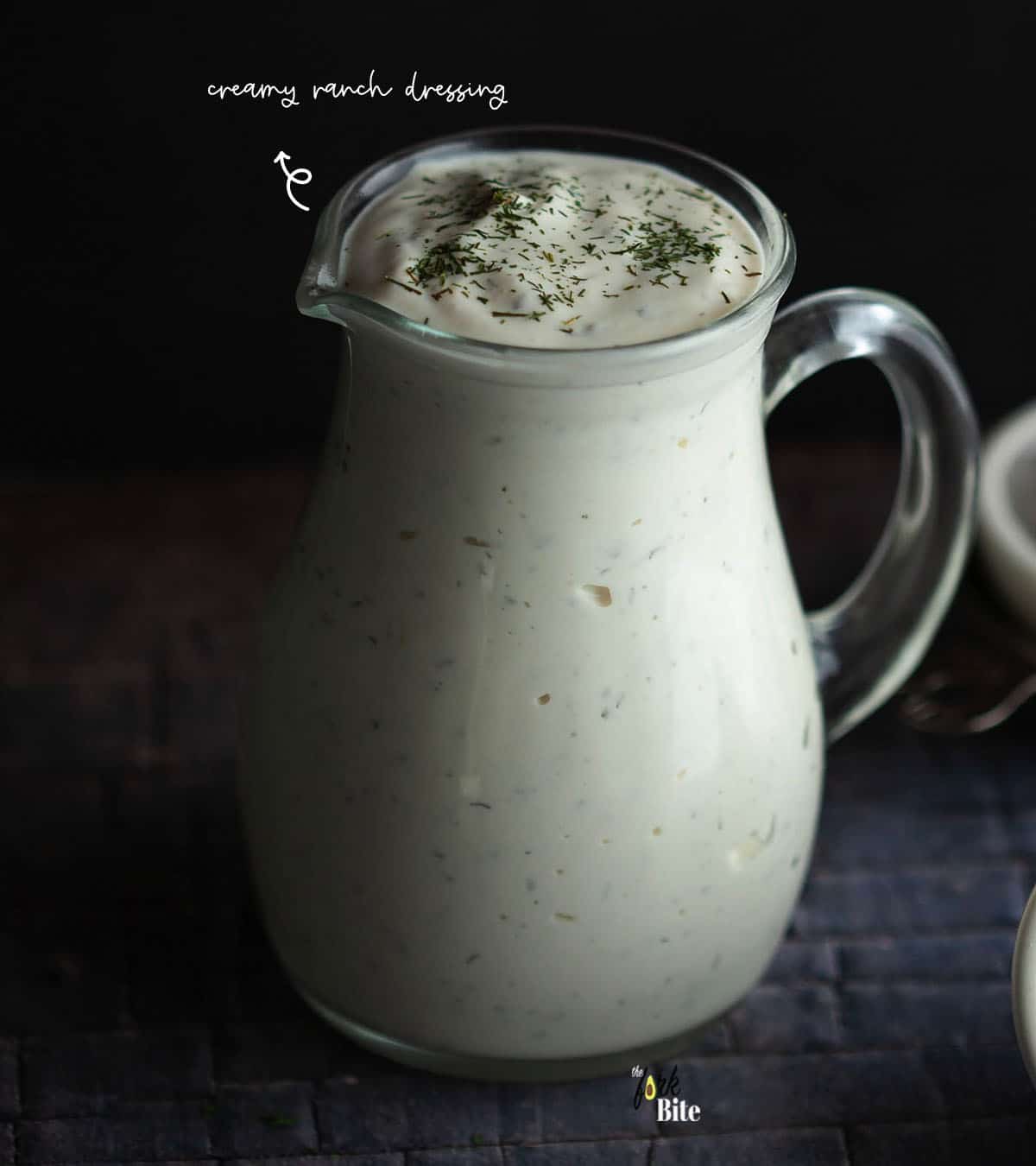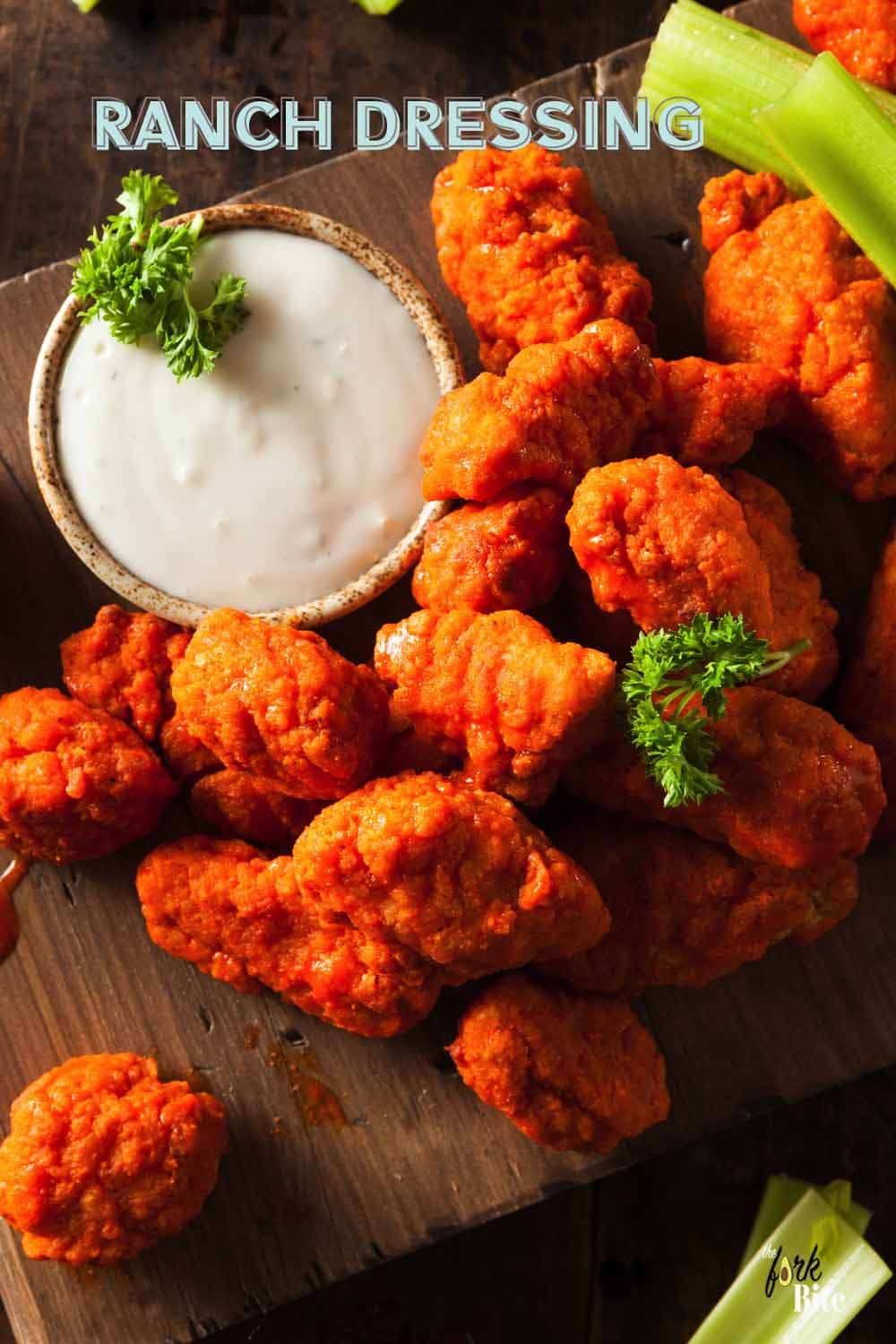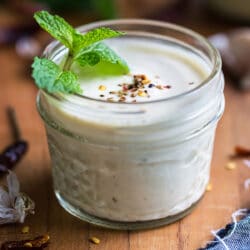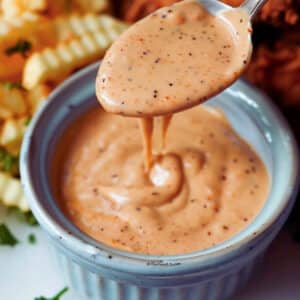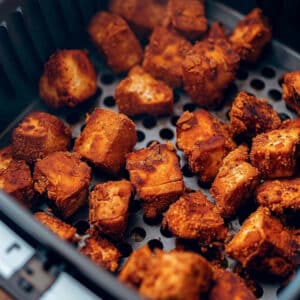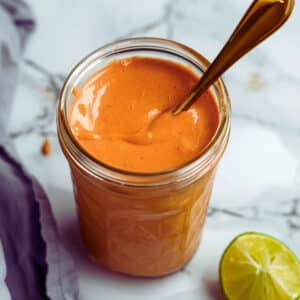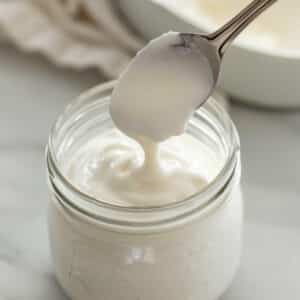Can you freeze ranch dressing? Yes, you can but the consistency and the overall texture may change. Learn the proper way to freeze it by reading more below. Dips with a base of creamy sour cream – such as ranch – are trendy appetizers for parties and other types of social events.
This is especially true when served with small, bite-sized vegetables and various kinds of chips. These dips combine multiple robust seasonings, creamy buttermilk, a rich, savory, sour cream, and other ingredients that provide an immense burst of flavor, such as chives and dried herbs.
Can you freeze ranch dressing?
Typically, ranch dressings are stored in the refrigerator; however, if you have some that you would like to preserve longer than a few days, you may freeze it.
Once thawed, it will be safe for consumption, but the consistency and the overall texture may change. You can check my post here for the best Wingstop ranch dressing recipe.
How to freeze ranch dressing
Step 1
(Option 1)
Place your ranch dressing or dip into a clean ice cube tray, using a tablespoon. Then place the tray in the freezer. Once the cubes are solid, you may pop them out of the tray and transfer them to a Ziplock freezer storage bag.
(Option 2)
Place the dressing or dip into a heavy-duty freezer bag that zip closes. Ensure that 1-inch of space remains after closure to allow for expansion during the freezing process. Alternatively, the leftovers may be placed in an airtight container.
Step 2
Remove all remaining air inside of the freezer bag. Tilt the bag slightly to the side and press down to get the air out. Immediately seal. If using a container, ensure the lid is firmly sealed.
Step 3
Label the container or plastic bag you have used with the date.
Step 4
You may freeze it at 0°F for a total of 2 months. Once you are ready to use, transfer to the refrigerator to thaw. When ready to consume, whisk to ensure a creamy consistency.
How to thaw
- If you used the cube method for freezing, place several into a jar or a bowl and transfer them to the refrigerator.
- For immediate consumption, heat in ten-second intervals in a microwave on the lowest heat setting.
- The whey and the buttermilk in the dressing will separate during the freezing process. Before eating, thoroughly stir the mixture to combine the liquids.
To freeze or not to freeze
Typically, freezing serves no purpose for dressings and dips.
It is possible to freeze dressings utilized for salads; however, you will experience different results. These products are known for extended shelf life. This is especially true if they have a natural preservative as part of the ingredients, such as vinegar. If the product contains mayonnaise, cheese, cream, and other dairy products, the shelf life is lessened, and freezing is an ideal option.
- Unfortunately, dairy products are known for not freezing well. If they are frozen, the thawing process presents its share of challenges. These ingredients will separate once thawed out. Whisking and whipping are possible, and while this may help combine the ingredients, most never mix thoroughly.
In turn, the dressing or dip is likely to come out curdled or even lumpy. Naturally, these characteristics are not highly favored in terms of condiments and dips. Additionally, the herbs, spices, and other seasonings may completely change flavor once frozen.
Ingredients such as cloves, celery, green peppers, and garlic increase in flavor and typically turn bitter when frozen.
Salt loses its flavor and increases rancidity in dishes containing fat, and the dressings and dips combine both salt and fats. Other ingredients like curry, paprika, onion, and other seasonings also experience a change in flavor once frozen.
To avoid flavor issues, we recommend adding the seasonings once the dressing or dip has thawed; however, in store-bought dressings and dips, these seasonings are already located within the product.
Despite these issues and warnings, if you elect to engage in freezing your dip or dressing, follow the recommendations outlined below.
- All liquids experience expansion when frozen. Before placing in a freezer, the liquid-based dressings and dips should be removed from original containers (if store-bought) and put into freezer-safe containers.
- Always leave extra space between the top of the dressing so that the liquid may expand adequately.
- If there's no ample room for expansion, the container will crack.
- When thawing, allow the contents to sit in the refrigerator overnight.
Rules for properly freezing food
While freezing is not considered complicated, you need to follow some rules to ensure the appliance's proper use. These rules help outline which things you can place in the freezer and which ones you cannot.
Rule 1
If the product did not taste good in the beginning, it would not taste good after freezing. This is the cardinal rule when it comes to freezing. In this case, the taste will only get worse. If you didn't like it to start with, don't bother freezing as this only changes the texture, not the taste.
Rule 2
If freezing items with a high level of moisture that is raw (such as fruits like watermelon and oranges), don't expect to consume it raw after freezing.
That moisture that keeps fresh fruits and vegetables crispy will behave much differently once they are frozen and then thawed. If you plan on using those items for cooking, you may be able to freeze and thaw.
For example, Tomatoes will cook well after being frozen and thawed; however, lettuces and cucumbers - don't even bother.
Rule 3
Beware of freezing anything creamy - such as items that contain dairy.
Examples include yogurt, cheese blocks, and custards. The curds within these dishes will separate from the whey. While it may go in nice and creamy, it will come out with separated ingredients and looking quite strange.
Note:
If utilizing certain dairy products for cooking, it is possible to freeze and thaw; however, you should use extreme caution.
For the most part, we are referring to foods that are frozen individually.
These rules are subject to change when freezing with other ingredients or as part of a dish that has been created.
Let's consider celery, for example. If you have a few stalks leftover, you can't just throw them in the freezer to use later. Don't even think about it.
Once opened, how long does ranch dressing or dip last?
The answer to this question depends on the conditions in which you stored it. To increase the product's overall shelf life, ensure it is tightly covered and place in the refrigerator.
How long will ranch salad dressing last in the fridge?
If continuously refrigerated, the product will retain its flavor and quality for anywhere from 6 to 9 months.
Is dressing still safe to use after the expiration date?
Yes, if the package has not been damaged and stored correctly, it is still safe. If there are no signs that the product has spoiled or any other cause for concern, it may be consumed.
The date listed on the packaging is not a date that outlines safe consumption. It is a date that outlines how long the manufacturer estimates that it will remain at a peak level of quality.
The coloring, texture, and even the flavor may likely start to change immediately following this date. The quality dates are often listed as "Best Before," "Best if Used By," or "Best When Used By."
In some cases, a numeric date may be listed with no wording. Always use your best judgment to ensure you do not consume bad products.
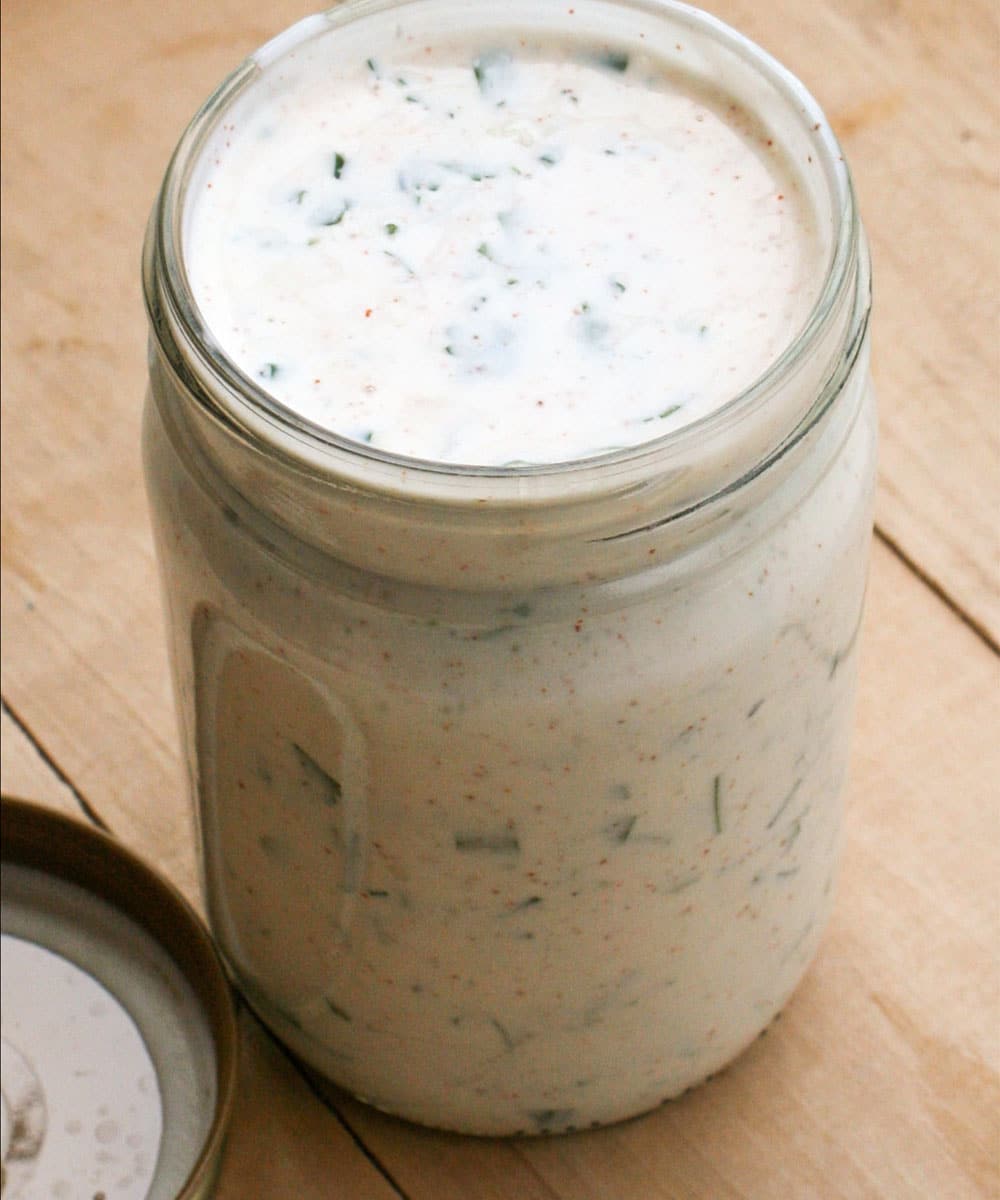
Is it easy to tell if ranch dressing has been spoiled or bad?
Yes, it is. Observe the product to see if the appearance is off. Also, look for signs of mold growth. An unusual odor often indicates it is bad. If you see no visible signs, taste a small bit of the product. If something is off, discard it immediately.
If I don't refrigerate the dressing, what will happen?
If the dressing is not kept cool, the oils in it will go bad. While it is true that the oils contained in the dressing act as a preservative, the heat will result in those oils becoming rancid.
In most instances, it will not harm you to eat it; however, it will not taste good at all.
How long will ranch dressing last if it is homemade?
The homemade ranch dressing recipe includes buttermilk, sour cream, and mayonnaise. Due to the inclusion of these ingredients, you should immediately store the finished product in the refrigerator.
I have found that this recipe lasts about a week when stored in the fridge. You must ensure that you use only the freshest ingredients, though.
Vinaigrettes last up to two weeks; however, it is the dairy products that last less. If you use fresh ingredients -like herbs and onions -the refrigerator shelf life is a week.
If you fail to use fresh ingredients, it will not last as long. If you want your homemade dressing to last longer, you may freeze it; however, the ingredients may separate when thawing.
If this happens, you may add a small amount of ranch mayonnaise or even sour cream and then whisk together to bring all of the ingredients back together as one and refresh your dressing.
How to thicken up my dressing?
When making ranch dressing, you may find it ends up being too thin or watery.
- In this instance, use a couple of spoonsful of mayonnaise or sour cream. Mix until the desired consistency is reached.
When adding your milk, be careful not to add too much. Otherwise, you will end up with a dressing that is entirely too thin. If you find that you have gone too far with the milk, it is easy to get back on track.
Regular mayonnaise or ranch mayonnaise may be used as a filler when attempting to get a higher level of consistency that will thicken up the dressing.
How does ranch dressing get its flavor?
Ranch dressing is used on salads and may also be used as a sauce and/or a dip. It is a versatile product that combines mayo, buttermilk, sour cream, and various spices.
The onion powder, chives or dill, garlic powder, and parsley combined with the sour cream play the largest role in its flavor. They mix as an oil emulsion recipe to create a unique sauce blend.
What makes restaurant ranch dressing taste so good?
Many restaurants use shelf-stable bottled versions; however, many utilize powdered packet mixes to create ranch dressing. The most commonly used is Hidden Valley Ranch.
These contain pre-measured amounts of powdered buttermilk, salt, and basic herbs. They are then combined with milk or buttermilk, mayonnaise, sour cream, and possibly other herbs to create their immense flavoring.
They use the same essential ingredients as from-scratch versions of the recipe.
The main difference with restaurants is the base of dairy. Pre-made bottles are used containing a large amount of oil, but eggs and other types of dairy products are also used.
The amount of oil contained in homemade dressing is much less. Because packets are used and added to the mixture during the creation process, it results in better quality and better-tasting products in the restaurant.
Are ranch mayonnaise and ranch dressing the same thing?
Each is similar due to the herb and spice mixture it takes to create each; however, there is an immense difference in each's texture.
The dressing is always thinner and mixes with food products nicely. The ranch mayo – on the other hand – has a very thick consistency. The dressing is pourable where the mayonnaise is more spreadable.
The dressing is best for salads. The ranch mayonnaise is better on sandwiches. You may use both interchangeably, but depending on what you are eating, you may find yourself with quite a mess on your hands if you opt for the thinner dressing.
- If you are dipping vegetables, for example, either choice is ideal.
- If you are making a sandwich, ranch mayonnaise is the better option.
- If having a chef salad, naturally, you should choose the ranch dressing.
- Many of the ranch-flavored dips are comparable to the ranch mayonnaise in terms of texture and consistency.
Interesting recipes
Freezing Ranch Dressing (How To)
Pin RecipeEquipments:
- Ziplock bag
- ice cube tray
Ingredients:
- ranch dressing
Instructions:
Option 1:
- Place your ranch dressing or dip into a clean ice cube tray, using a tablespoon. Then place the tray in the freezer.
- Once the cubes are solid, you may pop them out of the tray and transfer them to a Ziplock freezer storage bag.
Option 2:
- Place the dressing or dip into a heavy-duty freezer bag that zip closes.
Continue the process after option 1 or option 2:
- Ensure that 1-inch of space remains after closure to allow for expansion during the freezing process. Alternatively, the leftovers may be placed in an airtight container.
- Remove all remaining air inside of the freezer bag. Tilt the bag slightly to the side and press down to get the air out. Immediately seal. If using a container, ensure the lid is firmly sealed.
- Label the container or plastic bag you have used with the date.
- You may freeze it at 0°F for a total of 2 months. Once you are ready to use, transfer to the refrigerator to thaw. When ready to consume, whisk to ensure a creamy consistency.
Please note that all nutrition information are just estimates. Values will vary among brands, so we encourage you to calculate these on your own for most accurate results.

